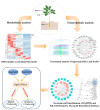Integrated Transcriptomic and Metabolomic Analysis Reveals Tissue-Specific Flavonoid Biosynthesis and MYB-Mediated Regulation of UGT71A1 in Panax quinquefolius
- PMID: 40141311
- PMCID: PMC11941809
- DOI: 10.3390/ijms26062669
Integrated Transcriptomic and Metabolomic Analysis Reveals Tissue-Specific Flavonoid Biosynthesis and MYB-Mediated Regulation of UGT71A1 in Panax quinquefolius
Abstract
Panax quinquefolius is a globally valued medicinal plant rich in bioactive flavonoids, yet the molecular mechanisms underlying their biosynthesis remain poorly understood. In this study, we integrated transcriptomic and metabolomic analyses to investigate tissue-specific flavonoid accumulation and regulatory networks in roots, leaves, and flowers. Metabolomic profiling identified 141 flavonoid metabolites, with flavones, flavonols, and C-glycosylflavones predominantly enriched in aerial tissues (leaves and flowers), while specific glycosides like tricin 7-O-acetylglucoside showed root-specific accumulation. Transcriptome sequencing revealed 15,551-18,946 DEGs across tissues, and the reliability of the transcriptomic data was validated by qRT-PCR. KEGG and GO annotation analyses suggested that these DEGs may play a crucial role in the biosynthesis and metabolism of secondary metabolites. From the DEGs, UGTs and MYB TFs were identified and subjected to correlation analysis. Functional validation through in vitro enzymatic assays confirmed that PqUGT71A1 catalyzes apigenin and naringenin glycosylation at the 7-OH position. Additionally, subcellular localization and yeast one-hybrid assays demonstrated that PqMYB7 and PqMYB13 interact with the PqUGT71A1 promoter and activate its expression.. This study unveils the spatial dynamics of flavonoid metabolism in P. quinquefolius and establishes a MYB-UGT regulatory axis, providing critical insights for metabolic engineering and bioactive compound optimization in medicinal plants.
Keywords: American ginseng; Panax quinquefolius; flavonoid biosynthesis; transcriptomic and metabolomic integration study.
Conflict of interest statement
This research was conducted in the absence of any commercial or financial relationships that could be construed as a potential conflict of interest.
Figures







Similar articles
-
Integrated transcriptomic and metabolomic analyses reveal tissue-specific accumulation and expression patterns of monoterpene glycosides, gallaglycosides, and flavonoids in Paeonia Lactiflora Pall.BMC Genomics. 2025 Jun 4;26(1):561. doi: 10.1186/s12864-025-11750-3. BMC Genomics. 2025. PMID: 40468204 Free PMC article.
-
Global transcriptome and gene regulation network for secondary metabolite biosynthesis of tea plant (Camellia sinensis).BMC Genomics. 2015 Jul 29;16(1):560. doi: 10.1186/s12864-015-1773-0. BMC Genomics. 2015. PMID: 26220550 Free PMC article.
-
SMRT- and Illumina-based RNA-seq analyses unveil the ginsinoside biosynthesis and transcriptomic complexity in Panax notoginseng.Sci Rep. 2020 Sep 17;10(1):15310. doi: 10.1038/s41598-020-72291-1. Sci Rep. 2020. PMID: 32943706 Free PMC article.
-
Comparative physiological, biochemical, metabolomic, and transcriptomic analyses reveal the formation mechanism of heartwood for Acacia melanoxylon.BMC Plant Biol. 2024 Apr 22;24(1):308. doi: 10.1186/s12870-024-04884-1. BMC Plant Biol. 2024. PMID: 38644502 Free PMC article. Review.
-
Unlocking the potential of flavonoid biosynthesis through integrated metabolic engineering.Front Plant Sci. 2025 May 29;16:1597007. doi: 10.3389/fpls.2025.1597007. eCollection 2025. Front Plant Sci. 2025. PMID: 40510168 Free PMC article. Review.
References
-
- Qu C., Li B., Lai Y., Li H., Windust A., Hofseth L.J., Nagarkatti M., Nagarkatti P., Wang X.L., Tang D., et al. Identifying panaxynol, a natural activator of nuclear factor erythroid-2 related factor 2 (Nrf2) from American ginseng as a suppressor of inflamed macrophage-induced cardiomyocyte hypertrophy. J. Ethnopharmacol. 2015;168:326–336. doi: 10.1016/j.jep.2015.04.004. - DOI - PMC - PubMed
-
- Shao Z.-H., Xie J.T., Vanden Hoek T.L., Mehendale S., Aung H., Li C.-Q., Qin Y., Schumacker P.T., Becker L.B., Yuan C.S. Antioxidant effects of American ginseng berry extract in cardiomyocytes exposed to acute oxidant stress. Biochim. Biophys. Acta. 2004;1670:165–171. doi: 10.1016/j.bbagen.2003.12.001. - DOI - PubMed
-
- Yun T.K., Yun Y.S., Han I.W. Anticarcinogenic effect of long-term oral administration of red ginseng on newborn mice exposed to various chemical carcinogens. Cancer Detect. Prev. 1983;6:515–525. - PubMed
-
- Dodd G.F., Williams C.M., Butler L.T., Spencer J.P.E. Acute effects of flavonoid-rich blueberry on cognitive and vascular function in healthy older adults. Nutr. Healthy Aging. 2019;5:119–132. doi: 10.3233/NHA-180056. - DOI
MeSH terms
Substances
LinkOut - more resources
Full Text Sources

